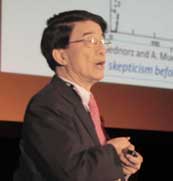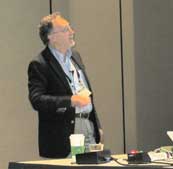History of Superconductivity Sessions
By George Zimmerman

Fig. 1. Session Chair Martin Blume
This year was the 100th anniversary of the discovery of superconductivity, and the APS March meeting in Dallas featured over a dozen sessions devoted to the phenomenon. The one sponsored by the Forum on the History of Physics took place at mid-morning on Monday, March 21, 2011. The five speakers at the session, chaired by Martin Blume (Fig. 1), dispelled some of the commonly held stories about the discovery of superconductivity, pointing to the intense interest of the physics community in that discovery. Some of the most famous names in physics at the time tried to find a theoretical explanation of the phenomenon, with little success. The speakers also highlighted some of the important discoveries about the nature of superconductivity that led to a theoretical understanding and reformulation, culminating in the Bardeen-Cooper-Schrieffer (BCS) theory [1]. The session concluded with a review of the present applications of superconductivity and their future promise.
The first speaker of the session was Dirk van Delft, Director of Museum Boerhaave at Leiden, who published an article in the September 2011 issue of Physics Today on the same subject and one in the March 2008 issue on the liquefaction of helium [2, 3]. The discovery of superconductivity can be pinpointed to 8 April 1911. Unlike the popular story that the observation of superconductivity was first thought to be a short circuit in the apparatus, the lab notes of Heike Kamerlingh Onnes reveal his awareness that he had discovered a new phenomenon. The results were announced in October of that year, both at Leiden and at the First Solvay Conference held in Brussels at the Metropole Hotel. The latter brought together such luminaries from the world of physics as A. Einstein, who was the second youngest member at the conference, M. Curie, M. Brillouin, H. Poincaré, and others. Another point highlighted by van Delft was that many of the experimental discoveries attributed to Kamerlingh Onnes, a theoretical physicist, would not have been possible without the expert technicians he had in his employ. While he acknowledged these technicians, they were not made co-authors on the publications.

Fig. 2. Brian Schwartz of CUNY.
The second speaker was Brian Schwartz (Fig. 2), currently at the Graduate Center at CUNY and previously associate Director of the Francis Bitter National Magnet Laboratory. Schwartz outlined the discoveries and phenomenological or other theories which lead to the eventual formulation of the BCS theory [1]. These included the Meissner effect, by Meissner and Ochsenfeld in 1933 [4], the isotope effect discovered independently by E. Maxwell and B Serin et al. in 1950 [5, 6], and the energy gap (See reference 30 in [1]) in 1953-4 which became evident from many experimental results. Schwartz also reviewed some of the phenomenological formulations, among which were the two fluid theory developed by Casimir and Gorter in 1934 [7] and also L. Tisza, the Heintz and Fritz London formulation of Maxwell’s equations for superconductivity [8], the Pippard non-local theory [9], and the Ginzburg-Landau equations [10].
Because the third speaker, Leon Cooper—the "C" in the BCS theory [1]—was unable to attend the March meeting, a video was shown of him speaking before an audience at Brown University on December 10th, 2010 entitled "The Road to and from BCS."
His lecture briefly described the discovery of superconductivity by Kamerlingh Onnes and the interest it evoked in the world of physics at that time. It then went on to an enumeration of some of the unsuccessful attempts at theories trying to explain the phenomenon. Those attempting explanations included Einstein, Feinman, Froelich, and even Bardeen [11], the "B" in BCS. Cooper then detailed the intense activities and calculations undertaken by him, Schrieffer and Bardeen, who wrote an article on superconductivity in the Encyclopedia der Physik only a few years before the BCS theory was published. The talk concluded with a review of the technological promises of superconductivity and a call in support of pure research, since the outcome of such investigations might not be utilized for years or decades. A link to this talk is available on the web at:
https://dropbox.brown.edu/download.php?hash=679d1d78.
John M. Rowell, the fourth speaker, who is now at the Arizona State University and was at The Bell Labs from 1961 to 1983, described developments after the BCS theory from 1957 to 1967, which enabled superconductivity to be applied to the production of high magnetic fields for particle accelerators and Magnetic Resonance Imaging. His talk entitled "Giaever, Nb3Sn, and Josephson" described the experiments, which led to the measurement of the energy gap and the discovery of the "Hard or Type II" superconductors, which enabled the manufacture of wires which were superconducting in high magnetic fields although partially penetrated by them. The understanding of the Abrikosov vortex structure contributed greatly to that advance. He then went on to the prediction of the Josephson effect and its applications in extremely sensitive measuring devices.

Fig. 3. Paul Chu of the University of Houston.
The final speaker was Paul Chu (Fig. 3), of the Texas Center for Superconductivity, University of Houston, who with scientists at Bell Labs is widely credited in the creation of materials raising the transition point of high temperature superconductors above the boiling point of liquid nitrogen, thus making them usable with much less maintenance than required by the previously used cryogen, helium. Chu begun by pointing out the excitement with which discoveries are made, especially in superconductivity, and reviewed the history of experiments aimed at the discovery of materials with ever higher superconducting transition temperatures. These included the efforts of B. Matthias, who managed to raise the transition temperature of alloys above 20K. Chu then discussed the discovery of high temperature superconductivity in 1986 by J.G. Bednorz and K. A. Miller, and the quest to synthesize materials with higher temperature transition points. That brought renewed attention to the subject, culminating in the "Woodstock of Physics" at the 1987 March meeting in New York City, and a demonstration before President Ronald Reagan – the pinnacle of the United States national interest in superconductivity. Although the number of publications dealing with high temperature superconductivity has declined, research is ongoing and applications are coming on line. The talk concluded with a vision of the great promise in the application of high temperature superconductivity to the storage and transmission of "green" electrical power in the near future.
All of these talks will be posted on the FHP website in the near future.
Another session on superconductivity was sponsored by the FHP at the April Meeting in Anaheim California. That session took place on May 1 and featured three speakers, with Martin Blume presiding. The first speaker, Peter Pesic of St. John’s College, provided a historical timeline that began in 1832 when Michael Faraday liquefied chlorine, and included Van der Waals’ formulation of the gas equations in 1873, William Ramsey’s discovery of helium on earth in 1895, William Dewar’s 1898 liquefaction of hydrogen, and Heike Kamerlingh Onnes—who was one of Van der Waals’ students—liquefying helium in 1908. Three years later superconductivity was discovered in mercury. This, Pesic pointed out, was only one of the achievement of the "Golden Age" of Dutch science. An adjunct to the Kamerlingh Onnes laboratory in Leyden was a school for skilled technicians, and the use of that facility and personnel was a significant factor in the discovery of superconductivity. Giles Holst, one of Kamerlingh Onnes’ assistants, was actually the one who first observed the phenomenon. At that time, the Leyden team also observed the 2.2K superfluid transition of liquid helium but was not aware of what it was. In 1914 the team demonstrated a conducting ball floating above a superconducting ring. A sketch of this experiment by Gerrit Flim, an assistant to Kamerlingh Onnes, was made in preparation for the actual experimental performance indicating the understanding of the superconductivity phenomenon.

Fig. 4. David Larbalestier
David Larbalestier, of the National High Magnetic Field Laboratory and Department of Physics, Florida State University, provided an overview of the practical applications of superconductivity. He pointed out that it took much preparation and careful planning to liquefy helium in order to carry out the discovery. After being hired by Leyden in 1882, Kamerlingh Onnes did not publish any articles for ten years. However, from the time of the discovery of superconductivity, he was pursuing practical applications. According to Larbalestier’s abstract, "In fact Onnes came to Chicago in 1913, just two years after discovering superconductivity, with a detailed plan to make a 10 T superconducting magnet!" The unexpectedly low critical current of mercury made that project unfeasible; but 48 years later, the discovery of type II superconductors made high field magnets possible. Larbalestier then went into the details of superconducting wire and magnet design and their applications in MRI and particle accelerators. The discovery of high transition temperature superconductors (HTTS), which took place 25 years ago, is only now leading to improvements in the superconductor tape-wire current-carrying properties over those of the type II superconductor technology. He went on to describe the problems that had to be overcome to manufacture HTTS wires of which brittleness and grain boundaries of the materials were prominent. He then reviewed methods by means of which one could overcome those difficulties. He concluded with the statement that "Today Nb-Ti (Tc = 9 K, Hc2(4K) = 10 T) is the conductor of choice. YBCO (Tc = 92 K) is a potential challenger. The search is on for much higher Tc – but that is another story…"
The third speaker, A. Zee of the University of California, Santa Barbara concluded the session with observations on how superconductivity theory, especially the Ginsburg-Landau formulation [10], extends far beyond superconductors and influenced particle physics theory and quantum field theory. Those views paralleled those given at a talk at the March Meeting session J3, on March 22, 2011, given by Frank Wilczek, who presented a "modern perspective on some classic applications of the ideas of superconductivity theory to fundamental particle physics: spontaneous chiral symmetry breaking in vacuum QCD, the Higgs mechanism in electroweak theory, and color superconductivity in dense hadronic matter; and also the confinement problem." That session was a Kavli Foundation Special Symposium: Nobelist Perspectives on 100 Years of Superconductivity, sponsored by the DMP and DCMP.
References:
[1] J. Bardeen, L.N. Cooper, J.R. Schriefer, Phys. Rev. 108, 1175 (1957).
[2] Dirk von Delft and Peter Kes, Physics Today, 63 (September 2010), p. 38.
[3] Dirk von Delft, Physics Today, 61 (March 2008), p. 36.
[4] W. Meissner, and R. Ochsenfeld, Naturwissenschaften 21, (44), 787 (1933).
[5] E. Maxwell, Phys. Rev. 78, 477 (1950).
[6] C.A. Reynolds, B. Serin, W.H. Wright, and L. B. Nesbitt, Phys. Rev. 78, 487 (1950).
[7] C.J. Gorter and H.B.G. Casimir, Z. Physik 35, 963 (1934).
[8] H. London and F. London, Proc. Roy. Soc. (London) A149, 71 (1935).
[9] A.B. Pippard, Proc. Roy. Soc. (London) A216, 547 (1953).
[10] V.L. Ginzburg and L.D. Landau, Zh. Eksp. Teor. Fiz. 20, 1064 (1950).
[11] J. Bardeen, Encyclopedia of Physics (Berlin: Springer Verlag, 1956), Vol. 15, p.274. Also references in [1]
(All photographs in this article by George Zimmerman)
The articles in this issue represent the views of their authors and are not necessarily those of the Forum or APS.
